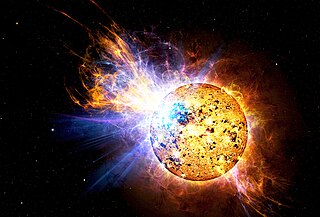EV Lacertae
|
Star EV Lacertae |
|||||||||||||
|---|---|---|---|---|---|---|---|---|---|---|---|---|---|

|
|||||||||||||
| Artist's impression of the EV Lacertae flare | |||||||||||||
| AladinLite | |||||||||||||
|
Observation dates equinox : J2000.0 , epoch : J2000.0 |
|||||||||||||
| Constellation | lizard | ||||||||||||
| Right ascension | 22 h 46 m 49.73 s | ||||||||||||
| declination | + 44 ° 20 ′ 2.4 ″ | ||||||||||||
| Apparent brightness | 10.29 mag | ||||||||||||
| Typing | |||||||||||||
| B − V color index | +1.59 | ||||||||||||
| Spectral class | M4.5 Ve | ||||||||||||
| Variable star type | UV + BY | ||||||||||||
| Astrometry | |||||||||||||
| Radial velocity | (0.40 ± 0.11) km / s | ||||||||||||
| parallax | (198.01 ± 0.04) mas | ||||||||||||
| distance | (16.46 ± 0.01) ly (5.05 ± 0.01) pc |
||||||||||||
| Visual absolute brightness M vis | +11.7 mag | ||||||||||||
| Proper movement | |||||||||||||
| Rec. Share: | (−706.15 ± 0.07) mas / a | ||||||||||||
| Dec. portion: | (−458.78 ± 0.06) mas / a | ||||||||||||
| Physical Properties | |||||||||||||
| Dimensions | (0.328 ± 0.007) M ☉ | ||||||||||||
| radius | (0.337 ± 0.010) R ☉ | ||||||||||||
| Age | 300 mill. A | ||||||||||||
|
Other names and catalog entries |
|||||||||||||
|
|||||||||||||
| annotation | |||||||||||||
|
|||||||||||||
EV Lacertae (short EV Lac ), other name Gliese 873 , is a variable star in the constellation Lizard (lat. Lacerta ).
It is a red dwarf , whose mass corresponds to about a third of the mass of our sun and which is only one percent of its brightness. EV Lacertae is 16 light years from Earth and, with an estimated age of 300 million years, is still a young star that has been noticed by radiation eruptions for a long time . These are indirectly the result of its young age, as it still rotates quickly and the magnetic field on the surface is strongly twisted . The radiation eruptions occur when the energy stored in the magnetic field is suddenly released during a short circuit ( reconnection ) of the magnetic field lines .
The star became famous through a huge radiation eruption on April 25, 2008, the strong X-ray and gamma radiation of which was registered by the two satellite telescopes Wind and Swift . It was the strongest burst of radiation that has ever been observed in a normal star. So far, astronomers have only known similar eruptions from neutron stars .
Individual evidence
- ↑ a b c d e EV Lac. In: SIMBAD . Center de Données astronomiques de Strasbourg , accessed on February 23, 2019 .
- ^ Hipparcos catalog (ESA 1997)
- ↑ a b EV Lac. In: VSX. AAVSO , accessed February 23, 2019 .
- ↑ a b P. E. Kervella, F. Arenou, F. Mignard, F. Thévenin: Stellar and substellar companions of nearby stars from Gaia DR2. Binarity from proper motion anomaly . In: Astronomy & Astrophysics . 623, p. A72. arxiv : 1811.08902 . bibcode : 2019A & A ... 623A..72K . doi : 10.1051 / 0004-6361 / 201834371 .
- ↑ ev-lacertae
- ^ A flare on EV Lacertae
- ↑ Small star with a large flare
- ↑ NASA - Pipsqueak Star Unleashes Monster Flare